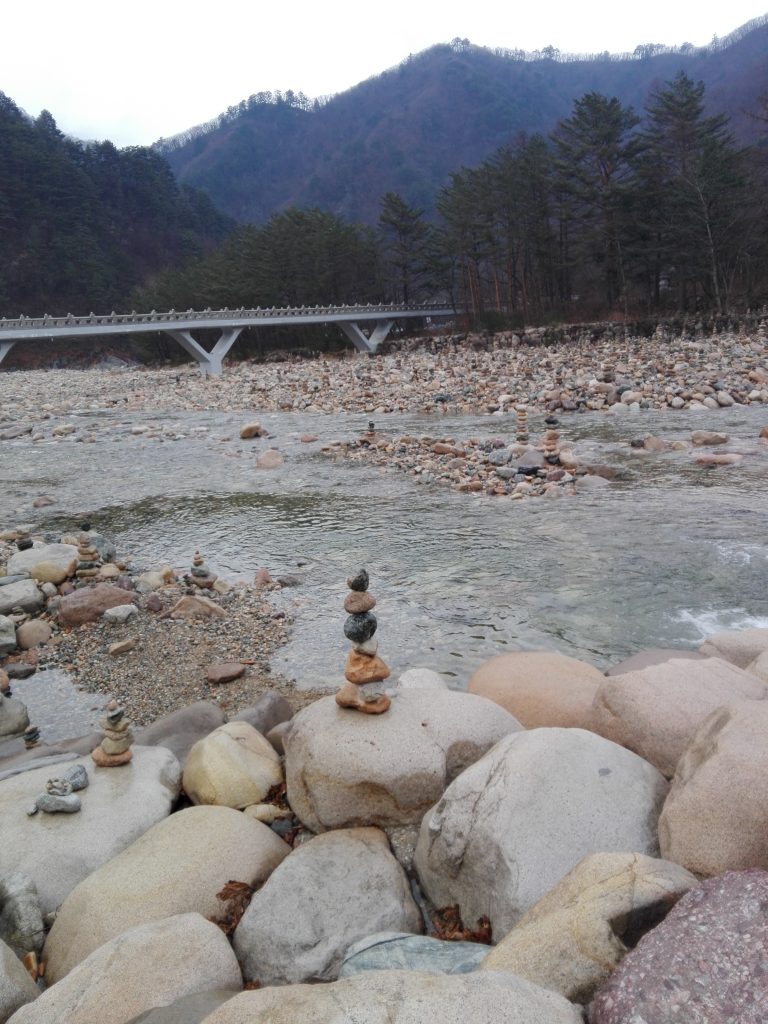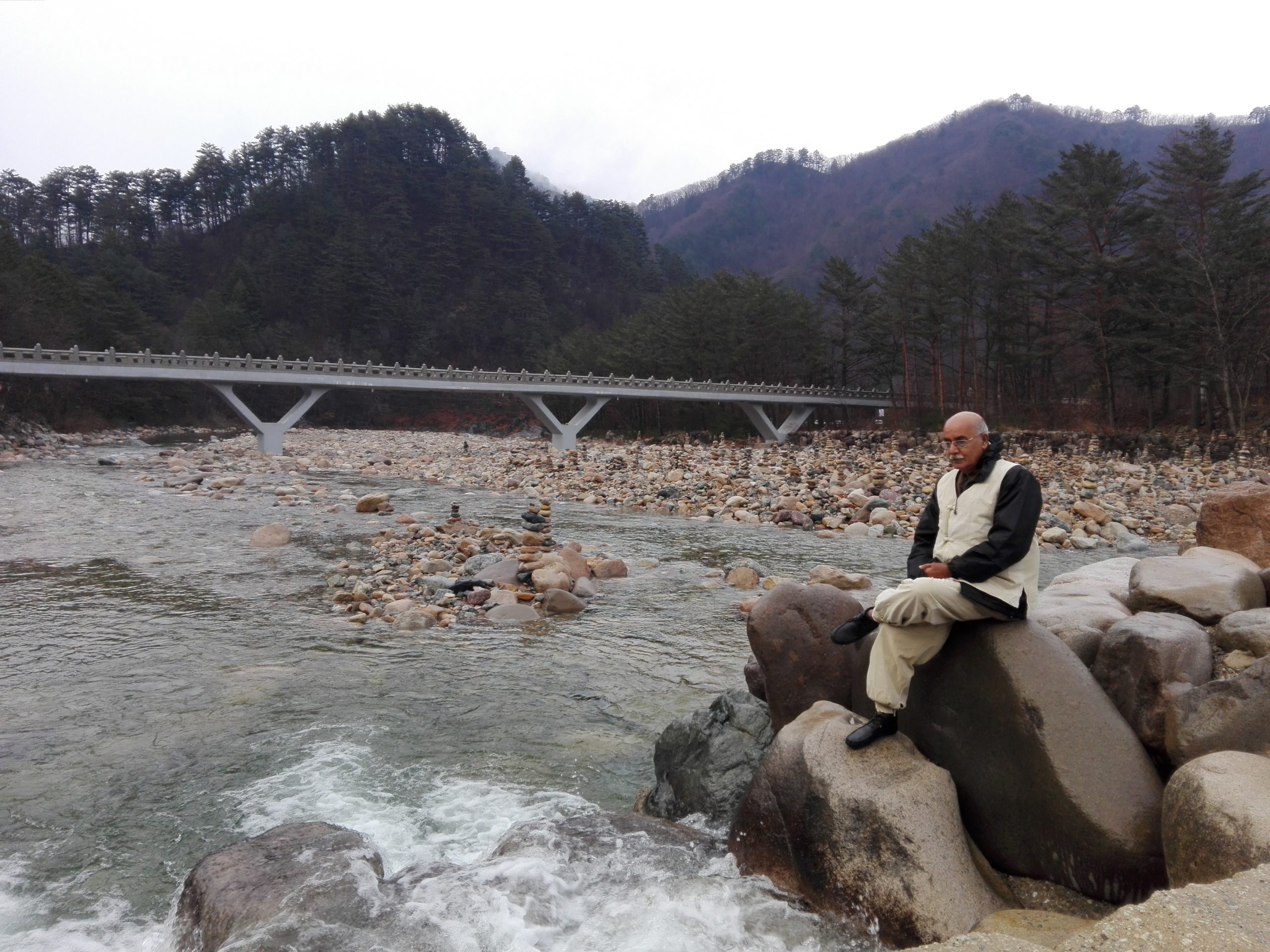
The believers use to erect the pagoda-shaped stone towers, as Buddha’s remains are placed at a stone pagoda. It is said that the wishing stone towers can only be seen by the people with a pure heart.
Nasir Aijaz
It was chilling winter of 2008. The sun had almost set behind the Korea’s Mt. Seoraksan and the dusk had enveloped the entire area – the thick forest spread all over the mountain, the stream flowing down with sounds resembling to musical notes along the spiral-shaped track and the structures of historic Baekdamsa Temple. I stood mesmerized by the serenity of the ambiance gazing at some people sitting in the bed of stream erecting small towers of pebbles. The curiosity took me close to those people to inquire about placing the pebbles in Pagoda style. Although we didn’t understand each other’s language, but the universal language of signs helped me to know that this was the way of praying for realization of their wishes. Soon, they all left down the valley by foot, as the darkness of falling night was fast covering the area into its arms.
With intense feeling of calmness, I stood there alone looking at thousands of stone towers, locally called as ‘Wishing Stone Towers’, spread all over the stream bed. I had first visited the Baekdamsa Temple in 2007 and had experienced a ‘Buddhist Lunch’ at the temple hosted by the Chief Monk for the delegates of Asia Journalists Association (AJA) but the second visit again organized by AJA included a night stay at temple, which provided opportunity to observe ‘Wishing Stone Towers’.
 “A unique way of faith-healing,” I thought, which took me back to my country-Pakistan where the people use to visit shrines of Sufi (Mystic) saints for the same purpose, as the Sufism offers more space to the people – be it a Muslim, Hindu or hailing from any other religion or faith. Majority of people from different religions, mostly in Pakistan, India, Bangladesh and Nepal as well as some other neighboring countries, visit shrines (the graves of those whom people ‘believe’ were pious) and ask the souls of the ‘pious’ for health, birth of children, wealth, and things that only God can provide. These people claim that they’re really not asking the dead for these things, but using them as intercessors with God. Their belief is that because the pious did well in this world when they were alive, they are now in a position to act as intercessors with God for those who invoke them. During their pilgrimage to the shrines, the people use to tie colored threads or strips of cloth to the tree branches and offer prayers besides taking part in Dhamal, the mystic dance at the drum beating. The hours-long meditation at the secluded places near the shrines is also part of the faith-healing in Indo-Pakistan region.
“A unique way of faith-healing,” I thought, which took me back to my country-Pakistan where the people use to visit shrines of Sufi (Mystic) saints for the same purpose, as the Sufism offers more space to the people – be it a Muslim, Hindu or hailing from any other religion or faith. Majority of people from different religions, mostly in Pakistan, India, Bangladesh and Nepal as well as some other neighboring countries, visit shrines (the graves of those whom people ‘believe’ were pious) and ask the souls of the ‘pious’ for health, birth of children, wealth, and things that only God can provide. These people claim that they’re really not asking the dead for these things, but using them as intercessors with God. Their belief is that because the pious did well in this world when they were alive, they are now in a position to act as intercessors with God for those who invoke them. During their pilgrimage to the shrines, the people use to tie colored threads or strips of cloth to the tree branches and offer prayers besides taking part in Dhamal, the mystic dance at the drum beating. The hours-long meditation at the secluded places near the shrines is also part of the faith-healing in Indo-Pakistan region.
Faith healing is the ritualistic practice of prayer and gestures that are claimed to elicit divine intervention in spiritual and physical healing. Believers assert that the healing of disease and disability can be brought about by religious faith through prayer and/or other rituals that, according to adherents, stimulate a divine presence and power. Belief in such divine intervention is derived from religious belief.
There have been claims that faith can cure blindness, deafness, cancer, AIDS, developmental disorders, mental disorders, anemia, arthritis, corns, defective speech, multiple sclerosis, skin rashes, total body paralysis, and various injuries. Miraculous recoveries have been attributed to many techniques commonly classified as faith healing. It can involve prayer, a visit to a religious shrine, or simply a strong belief in a supreme being.
Faith healing can be classified as a spiritual, supernatural, or paranormal event, and, in some cases, belief in faith healing can be classified as magical thinking. The American Cancer Society states “available scientific evidence does not support claims that faith healing can actually cure physical ailments.”
Personally, I know many of the well-educated people, who spent several months at shrines abandoning their luxurious city life for spiritual satisfaction, but unfortunately, this entire region has also lots of the fake faith-healers who use to exploit the beliefs of pilgrims for their mileage, and for this reason, I always avoided visiting such places. However, the Buddhist temples presented a different character, which attracted me a lot.
 The AJA offered me a third opportunity on April 01, 2017 when it arranged a night stay at Baekdamsa Temple along with several other friends from different countries of Middle, South, Central and East Asia. Besides visit to various sections of Temple Complex, holding lectures, meditation session and taking part in candle-light procession, led by a nun, up to Susimgyo Bridge, we were also taken to the stream bed for witnessing the Wishing Stone Towers.
The AJA offered me a third opportunity on April 01, 2017 when it arranged a night stay at Baekdamsa Temple along with several other friends from different countries of Middle, South, Central and East Asia. Besides visit to various sections of Temple Complex, holding lectures, meditation session and taking part in candle-light procession, led by a nun, up to Susimgyo Bridge, we were also taken to the stream bed for witnessing the Wishing Stone Towers.
We came across the unique scene of Wishing Stone Towers in the valley beneath and on both sides of Susimgyo Bridge on the way to Baekdamsa Temple. “In rainy season of summer, these towers get washed away, yet more towers spring up,” the nun told.
“They are famous part of the landscape of Baekdamsa. The snowy mountain of Seorak, seen from Susimgyo Bridge, reminds you of lotus buds. The stone towers look like stamens,” she briefed.
It is said that the wishing stone towers can only be seen by the people with a pure heart. The believers use to come here for erecting the pagoda-shaped stone towers, as Buddha’s ‘sarira’ (Sanskrit language word sarir, which means human body. Here this word is used for Buddha’s remains) are placed at a stone pagoda located at highest point of Seoraksan Mountain, at a distance of six-hour walk, and is the most-visited place for believers.
While leaving the Baekdamsa Temple on the morning of April 02, I gazed again at the Wishing Stone Towers in admiration and conviction that this place offers a lot to get away from the materialist world and achieving inner spiritual satisfaction.
__________________
Nasir Aijaz is a senior journalist, author of nine books and Chief Editor of Sindh Courier